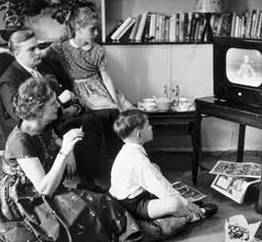Television Advertising
 Television is the biggest of the mass media available to advertisers. However, in recent years with the growth of satellite broadcasting, the numbers of channels available has grown substantially. This has meant that the audience size on the established terrestrial channels has declined. However, new channels are often more focused on a particular market segment or niche, which permits adverts to be played to an audience which is more likely to be receptive to the message.
Television is the biggest of the mass media available to advertisers. However, in recent years with the growth of satellite broadcasting, the numbers of channels available has grown substantially. This has meant that the audience size on the established terrestrial channels has declined. However, new channels are often more focused on a particular market segment or niche, which permits adverts to be played to an audience which is more likely to be receptive to the message.

Examples of Specialist Satellite Channels:
- Fishing Channel
- Eurosports
- The God Channel
- Fashion TV
- Sailing Channel
- Dating Channel
- Extreme Sports
- Travel Deals Direct
- Create and Craft
- Medical Channel
- History Channel
One potential problem facing advertisers is that newer technologies, incorporating a hard disk, allow the viewer to both record, and pause, live television. This also provides the opportunity to fast forward through the advert break, so removing any benefit to the advertiser.
Peak time advertising costs on television can be huge as can adverting during major cultural and sporting events:

Prices for a 30 seconds advert in the USA during the Super Bowl final in 2010 typically cost $2.6 million dollars and $5million dollars for a similar length spot during the Olympic Games in China.
Indeed, following the success of the Olympic Games, China is projected to become the fourth-largest global advertising market. Advertising spending in China stood at $120 billion in 2010. By far the greatest expenditure was on television advertising, supported by big-spending toiletries companies such as Procter & Gamble, Unilever and L'Oreal. Overall, the top-spending categories in China are toiletries, business and services, foodstuffs, pharmaceuticals and beverages.
The advertisement shown in the window below commemorates the 20th anniversary of Proctor & Gamble China. The advert links a variety of P&G products ranging from its Olay skin cream, to Rejoice shampoo and Pringles potato chips and demonstrating how much P&G's products have been incorporated into Chinese consumers' lives - so much so that viewers may even mistake the company for a Chinese firm. You can watch this advertisement in a separate window.
The following Coke advertisement celebrated the 2010 Chinese New Year and shows that like P&G, Coke has fashioned its campaigns for the Chinese mass market. The advert features the popular Taiwanese boy band Fahrenheit. Shows them exchanging red envelopes stuffed with cash, but then reunite via a live webcam chat to bring in the New Year. You can also watch this advertisement in a separate window.
Source: The China Observer
Advantages of television advertising
- Visual impact is high if advertisement is well designed
- Can be used to convey nature of the product through demonstration, sound and vision
- Some targeting of market segments is possible through selective use of advertising slots and appropriate channels
- Reaches a significant audience
- Can be effective for raising awareness and brand development
- Television ownership worldwide has increased as incomes rise
- High Definition and 3D technology has improved the impact of advertisements
Disadvantages of television advertising
- Expensive - not appropriate for all companies as large portions of the budget may be lost to inappropriate market segments
- Unsuitable for small firms where large demand could not be met
- Increasing use of recording and TV on demand services is leading to adverts not even being watched
- Increasing number of TV channels may water down message and reduce potential audience (though this may offer increased opportunities for greater market segmentation with more specialist channels)
- Not appropriate for conveying complex information or large amounts of information as timeslots tend to be short
- Viewers cannot refer back to the advert unless they record it
Consumers can now choose to watch television or video on other devices other than a traditional television set. In 2010, AC Nielsen, the US marketing research company, reported on how people were watching television and other video media. The introduction to this report says:
The history of video consumption has been additive. Consumers globally have proven their insatiable appetites for video-delivery of information and entertainment and new means and screens have proliferated. Whether it be standard TV, on the computer or on a mobile phone, viewership continues to grow, and will likely do so as new technologies enhance the experience and convenience.
To get a better sense for how the world is consuming video today, Nielsen recently conducted a survey of more than 27000 online consumers in 55 countries, asking simple questions about how they watch video. Looked at, in the context of Nielsen's more detailed syndicated measurement of video consumption across many markets, the result is a baseline understanding of the state of cross-platform consumption amongst global online consumers
You can view the slide show of this report by following the link below: